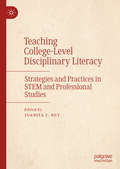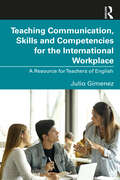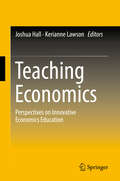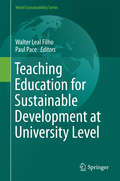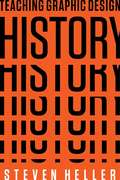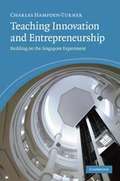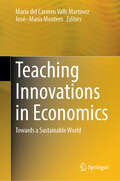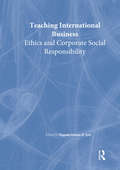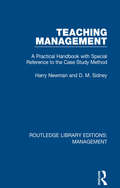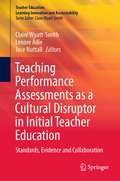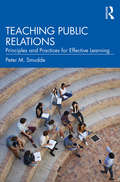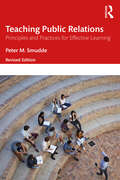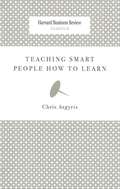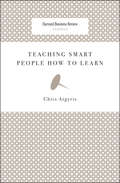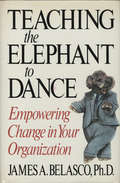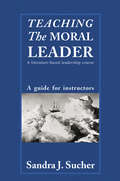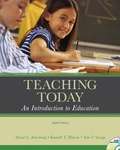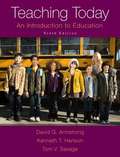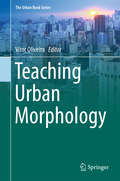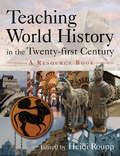- Table View
- List View
Teaching College-Level Disciplinary Literacy: Strategies and Practices in STEM and Professional Studies
by Juanita C. ButThis volume foregrounds the disciplinary literacy approach to college teaching and learning with in-depth discussions of theory and research, as well as extensive classroom illustrations. Built upon the current work of READ (Reading Effectively Across the Disciplines), a disciplinary literacy program at New York City College of Technology, it presents a broad collection of methodologies, strategies, and best practices with discipline-specific considerations. It offers an overview of the program informed by evidence-based research and practices in college disciplinary learning, describing how its unique model addresses the literacy needs of students in STEM and professional studies. Chapter authors, including administrators, literacy specialists, and content experts discuss program design, professional development, and assessments. They also outline strategies to foster disciplinary literacy pedagogy and college success in five content areas, including Accounting, Architecture, Biology, Electromechanical Engineering, and Mathematics.
Teaching Communication, Skills and Competencies for the International Workplace: A Resource for Teachers of English
by Julio GimenezBacked by evidence and research, this practical book presents an innovative yet comprehensive approach to teaching non-native English speakers the main communication and cultural competencies that are required to succeed in an international English-speaking workplace. Each unit includes strategies for teaching key skills, tasks to encourage reflection and notes on relevant cultural and technological issues. Practical features in each unit include lesson plans and materials, insights from research, extension tasks, reflection activities and further readings. Supported by current learning theories, key teaching methodologies and assessment materials, the chapters address the challenges that non-native English speakers may face in the international English-speaking workplace. Areas of focus include: Job hunting Job applications Interviews Interpersonal, written and spoken communication Performance appraisals Applying for promotions Written for pre-service, practicing and future teachers, with specific guidance for each role, this is an essential resource for all educators who want to confidently address the challenges that non-English speakers may encounter at work, including linguistic proficiency, cultural awareness and the use of technology.
Teaching Economics: Perspectives on Innovative Economics Education
by Joshua Hall Kerianne LawsonThis book looks at a number of topics in economic education, presenting multiple perspectives from those in the field to anyone interested in teaching economics. Using anecdotes, classroom experiments and surveys, the contributing authors show that, with some different or new techniques, teaching economics can be more engaging for students and help them better retain what they learned. Chapters cover a wide range of approaches to teaching economics, from interactive approaches such as utilizing video games and Econ Beats, to more rigorous examinations of government policies, market outcomes and exploring case studies from specific courses. Many of the chapters incorporate game theory and provide worked out examples of games designed to help students with intuitive retention of the material, and these games can be replicated in any economics classroom. While the exercises are geared towards college-level economics students, instructors can draw inspiration for course lectures from the various approaches taken here and utilize them at any level of teaching. This book will be very useful to instructors in economics interested in bringing innovative teaching methods into the classroom.
Teaching Education for Sustainable Development at University Level
by Walter Leal Filho Paul PaceThis book introduces readers to the latest research and findingsfrom projects focusing on teaching education for sustainable development atuniversities. In particular, it describes practical experiences, outlinecourses, training schemes and other initiatives aimed at promoting betterteaching on matters related to sustainable development at institutions ofhigher education. In order to meet the pressing need for publications tosupport sustainable development education, the book places special emphasis onstate-of-the art descriptions of approaches, methods, initiatives and projectsfrom around the world, illustrating how teaching education for sustainabledevelopment can be implemented at the international scale. The book represents a timely contribution to the disseminationof approaches and methods that may improve the way we perceive the importanceof teaching education for sustainable development, as well as how we implementit.
Teaching Graphic Design History
by Steven HellerAn Examination of the Practice Through the Years Teaching the history of graphic design cannot simply be outlined by dates nor confined by places, but is defined by concepts and philosophies, as well as those who made, make, and inspire them. Teaching Graphic Design History is the first collection of essays, syllabi, and guides for conveying the heritage of this unique practice, from traditional chronologies to eclectic themes as developed by today’s historians, designers, scholars, and documentarians. Long overlooked within the broader history of printing and typesetting, when graphic design’s artifacts finally became the subject of serious study, the historian had to determine what was worthy and on what the history of graphic design should focus: the makers or the artifacts, the content or the context, or all of the above. With the author’s distinct viewpoint and many exclusive contributions, Teaching Graphic Design History chronicles the customs and conventions of various cultures and societies and how they are seen through signs, symbols, and the artifacts designed for use in the public—and sometimes private—sphere. Areas of focus include: Social and political effects of graphic designPhilosophical perspectives on designEvolution of brandingDevelopment of the graphic design professionPredictions for the future of the practice An examination of the concerted efforts, happy accidents, and key influences of the practice throughout the years, Teaching Graphic Design History is an illuminating resource for students, practitioners, and future teachers of the subject.
Teaching Innovation and Entrepreneurship
by Charles Hampden-TurnerIs it possible to teach someone to be an entrepreneur? Is innovation something that can be assessed and taught in a classroom? Teaching Innovation and Entrepreneurship answers these and other questions by focusing on a teaching experiment in Singapore at Nanyang Technological University, wherein classes of English-speaking Singaporeans and Mandarin-speaking students from the People's Republic of China were subjected to an 'entrepreneurial eco-system'. Extending from the west coast of the USA to Singapore and Shanghai, this programme subjects students to a wide range of activities, including a four-month business simulation game where teams of students select their favourite inventions and pitch them to real venture capitalists with the inventors present. Drawing on the lessons learned from this highly successful experiment, the book argues that not only is it possible to describe the innovative process, we can also teach it, measure it, evaluate it and model it.
Teaching Innovations in Economics: Towards a Sustainable World
by José–María Montero María del Carmen Valls MartínezThis book highlights the latest technological innovations in economics education. Economics, as a discipline, not only studies the relationship between ends and scarce means, which can be used alternatively, but also serves as a social science that uses historical data to predict future events—a task complicated by the influence of human behavior. In economics, a solid theoretical foundation alone is insufficient; practical application requires a deep understanding of statistics. With the vast amount of information available today, data processing is now performed using specialized software. Consequently, teaching economics demands a wide range of complex skills that have significantly evolved in recent years, driven by the growing interest in educational innovation among professors and scientists, further accelerated by advancements in new technologies. Moreover, economics education is increasingly aligned with the global concern for sustainability, as emphasized in the United Nations' Agenda 2030. Professors are now integrating sustainability into syllabi and teaching methodologies. This book covers key topics such as: Technological and innovative advancements in economics education. New teaching-learning theories and models in economics education. The impact of digital transformation on economics education. The role of artificial intelligence in economics education. Addressing special educational needs in economics education. Evaluation of the teaching-learning process in economics. Assessment of student learning in economics. Development of materials and tools for economics education. Final projects (Undergraduate and Master's) in economics. Authored by leading professors and researchers in the field, this book presents a collection of chapters that rigorously explore teaching innovations in economics.
Teaching International Business: Ethics and Corporate Social Responsibility
by Erdener Kaynak Gopalkrishnan R IyerInstill social responsibility in your students!“Ethical behavior in international business is our strongest hope, especially at a time when alternative systems of governing individual and corporate behaviors are at their weakest levels.” --Gopalkrishnan R. Iyer, from the chapter “Approaches to Ethics in International Business EducationIn recent years there has been a rapid growth of academic and practical interest in business ethics and social responsibility at the corporate level. Teaching International Business: Ethics and Corporate Social Responsibility is a collection of academic writings on the issues and challenges of incorporating ethics and corporate social responsibility concerns into international business education. The logic of economic globalization presumes that economic principles and business ethics are universal, but in fact, cross-cultural realities and indigenous perspectives are often quite unique. Teaching International Business: Ethics and Corporate Social Responsibility covers the major perspectives in business ethics as they relate to international business.In Teaching International Business: Ethics and Corporate Social Responsibility, you will explore: techniques and approaches for teaching ethics and social responsibility to your students individual versus corporate responsibility cultural effects on generally accepted accounting principles (GAAP) cultural effects on generally accepted auditing standards (GAAS) globalization and its impacts ethical issues in international marketingTeaching International Business: Ethics and Corporate Social Responsibility brings you ethical issues and perspectives in economics, management, finance, accounting, and marketing. The broad range of approaches and issues presented here will be of immense use to educators teaching foundational international business courses. This volume will go a long way in gripping students’interests while delivering relevant educational information.
Teaching Macroeconomics with Microsoft Excel®
by Humberto BarretoHumberto Barreto gives professors a simple way to teach fundamental concepts for any undergraduate macroeconomics course using Microsoft Excel® with Excel workbooks and add-ins and videos freely available on his university website. The Excel files are designed to be used by students with any textbook, and have been used many times by the author in his own teaching. Each Excel workbook contains links to short screencasts, around five to ten minutes, that show the cursor and typing as the file is manipulated with narration that walks the student through the steps needed to complete a task. The book shows professors a simple way to present macroeconomic models and incorporate data into their courses.
Teaching Management: A Field Guide for Professors, Corporate Trainers, and Consultants
by James G. S. Clawson Mark E. HaskinsHow can every management class be a dynamic, unforgettable experience? This much-needed book distils over half a century of the authors' combined experience as university professors, consultants, and advisors to corporate training departments. In a lively, hands-on fashion, it describes the fundamental elements in every learning situation, allowing readers to adapt the suggestions to their particular teaching context. It sparks reflection on what we do in the classroom, why we do it, and how it might be done more effectively. The chapters are broadly organized according to things you do before class, things you do during class, and things you do in between and after class, so that every instructor, whether newly-minted PhDs facing their first classroom experience, experienced faculty looking to polish their teaching techniques, consultants who want to have more impact, or corporate trainers wishing to develop in-house teaching skills, can benefit from the invaluable advice given.
Teaching Management: A Practical Handbook with Special Reference to the Case Study Method (Routledge Library Editions: Management)
by Harry Newman D. M. SidneyOriginally published in 1955. This book, written by two men with experience of teaching management under both British and American conditions, examines various tried and tested techniques of management education. Its primary focus is on the case study approach to management education, including the writing of case studies and running a case study session, as a means of stimulating students to take an active part in the learning process.
Teaching Notes: Communicating the Teacher's Wisdom
by James E. AustinProvides guidance for the preparation of teaching notes. Sets forth the rationale for teaching notes, what they should contain and why, and how they can be prepared. Based on the experiences of Harvard Business School faculty.
Teaching Old Companies New Tricks: The Challenge of Managing New Streams Within the Mainstream
by Rosabeth Moss KanterDescribes the challenge of starting new ventures or new activities in established companies, especially if they diverge from the mainstream of ongoing commitments. Fledgling ventures require a different kind of management that acknowledges their uncertainty, intensity, and need/desire for freedom from mainstream constraints. One challenge is how integrated or not the new activity should be with the rest of the organization. Provides criteria for making this choice and offers some examples.
Teaching Performance Assessments as a Cultural Disruptor in Initial Teacher Education: Standards, Evidence and Collaboration (Teacher Education, Learning Innovation and Accountability)
by Claire Wyatt-Smith Joce Nuttall Lenore AdieThis book explores how well teachers are prepared for professional practice. It is an outcome of a large-scale research and development program that has collected extensive data on the impact of the Graduate Teacher Performance Assessment on Initial Teacher Education programs and preservice teachers’ engagement with the assessment. It contributes to international debates in teacher education by examining an Australian experience of teacher performance assessments as a catalyst for cultural change and practice reform in teacher education. The respective chapters describe and critique this unique, multi-institutional investigation into the quality of teacher education and present substantial evidence, drawing on a variety of conceptual, empirical and methodological entry points. Further, they address the intellectual, experiential and personal resources and related expertise that teacher educators and preservice teachers bring to their practice. Taken together, they offer readers clearly conceptualised and evidence-rich accounts of site-specific and cross-site investigations into cultural, pedagogical and assessment change in Initial Teacher Education.
Teaching Public Relations: Principles and Practices for Effective Learning
by Peter M. SmuddeExcellence in public relations begins with excellence in education in public relations programs, and this book presents a comprehensive, cohesive, and concrete approach for effective teaching and learning in PR classes. Teaching Public Relations puts in one concise volume salient matters about effective teaching and learning of public relations, including curriculum development and course design plus guides and tools for the work PR educators must do. This book is the first textbook of its kind, and systematically synthesizes current principles and practices for effective teaching and learning and applies them to public relations education in colleges and universities. Firmly situating public relations education (PRE) in context, the book goes on to outline principles and approaches for teaching and learning in PRE. Other features of the text include example documents that will help in designing assignments, courses, or curricula, and a comprehensive list of publications, organizations, online media, and other sources for further investigation and learning. This book is a solid starting point for anyone, especially public relations professionals, wanting to begin a career as a full-time or part-time professor of public relations at a college or university. It is also recommended reading for current teachers and students of PR research.
Teaching Public Relations: Principles and Practices for Effective Learning
by Peter M. SmuddeExcellence in public relations (PR) begins with excellence in education in public relations programs. In this book, Dr. Smudde brings together his industry expertise and over 20 years of teaching experience at higher education institutions to present a comprehensive and cohesive primer for PR educators.Newly updated to reflect five years of developments in the field of public relations since its initial publication in 2019, this revised edition of Teaching Public Relations puts in one concise volume salient matters about effective teaching and learning of public relations. It includes curriculum development and course design plus guides and tools for the work PR educators must do. This book remains the first textbook of its kind and systematically synthesizes current principles and practices for effective teaching and learning and applies them to PR education in colleges and universities. This book, however, is not a book of tips for teaching PR, although some are given at times when relevant. Firmly situating public relations education (PRE) in context, the book goes on to outline principles and approaches for teaching and learning in PRE. Other features of the text include example documents that will help in designing assignments, courses, or curricula, and a comprehensive list of publications, organizations, online media, and other sources for further investigation and learning.This book is a solid starting point for anyone, especially public relations professionals, considering a career as a full-time or part-time professor of PR at a college or university. It is also recommended reading for current teachers and students of PR research.
Teaching Smart People How to Learn
by Chris ArgyrisCompetitive success depends on learning, but most people, including professionals in leadership positions, are not very good at it. Learning is a function of how people reason about their own behavior. Yet most people engage in defensive reasoning when confronted with problems. They blame others and avoid examining critically the way they have contributed to problems. Companies need to make managers' and employees' reasoning patterns a focus of continuous improvement efforts.
Teaching Smart People How to Learn (Harvard Business Review Classics)
by Chris ArgyrisWhy are your smartest and most successful employees often the worst learners? Likely, they haven't had the opportunities for introspection that failure affords. So when they do fail, instead of critically examining their own behavior, they cast blame outward--on anyone or anything they can. InTeaching Smart People How to Learn, Chris Argyris sheds light on the forces that prevent highly skilled employees for learning from mistakes and offers suggestions for helping talented employees develop more productive responses. Since 1922,Harvard Business Review has been a leading source of breakthrough ideas in management practice-many of which still speak to and influence us today. The HBR Classics series now offers you the opportunity to make these seminal pieces a part of your permanent management library. Each volume contains a groundbreaking idea that has shaped best practices and inspired countless managers around the world-and will change how you think about the business world today.
Teaching The Elephant To Dance: Empowering Change in Your Organization
by James A. Belasco"But, we've always done it that way." This is a warning sign, a symptom of impending disaster for any organization.Shackled, like powerful elephants, to the past, organizations rob themselves of the ingenuity required to meet new competitive challenges and escape the "re" dimension trap of "re-engineering, re-organization and re-structuring that concentrate on short term fixes rather than long term solutions.Teaching the Elephant to Dance is a practical, hands-on guide for creating the right change in any organization, large or small, corporate or governmental, manufacturing or service based. Filled with illuminating case studies, it shows how to devise new corporate visions and strategies... how to overcome inertia .. and how to form labor-management partnerships. Clear, authoritative, practical and inspiring, Teaching the Elephant to Dance provides a step-by-step guide for making the impossible happen.
Teaching The Moral Leader: A Guide for Instructors
by Sandra J. SucherThis book is a comprehensive, practical manual to help instructors integrate moral leadership in their own courses, drawing from the experience and resources of the Harvard Business School course 'The Moral Leader', an MBA elective taken by thousands of HBS students over nearly twenty years. Through the close study of literature--novels, plays, and historical accounts-- followed by rigorous classroom discussion, this innovative course encourages students to confront fundamental moral challenges, to develop skills in moral analysis and judgment, and to come to terms with their own definition of moral leadership. Using this guide's background material and detailed teaching plans, instructors will be well prepared to lead their students in the study of this vital and important subject. Featuring a website to run alongside that links the manual with the textbook and provides a wealth of extra resources, including on-line links to Harvard Business School case studies and teaching notes this manual forms a perfect complement to The Moral Leader core text also by Sandra Sucher. The detailed and hands-on nature of the guide makes it possible for instructors, with or without a specialized background, to replicate the 13-session Harvard Business School course, or to integrate moral leadership into an existing course, or as a module, or as stand-alone sessions. The manual presents flexible class plans, easily adaptable to a wide variety of business and academic topics. It suggests how to adapt the course to other settings, provides supporting materials, and reviews the approach to teaching "The Moral Leader," differentiating it from other literature-based courses. The author, a Harvard Business School professor with a successful record in teaching this course, also brings into the text the kind of real world understanding of effective leadership development that comes from decades of experience as a high level corporate executive. An accompanying student book, focused on class preparation and the context of each work, helps students address questions like: What is the nature of a moral challenge? How do people "reason morally"? How do leaders – formal and informal – contend with the moral choices they face? How is moral leadership different from leadership of any other kind? Struggling with these questions, both individually and as members of a vibrant learning community, students internalize moral leadership concepts and choices, and develop the skills to pursue it in their careers and personal lives.
Teaching Today: An Introduction To Education
by David G. Armstrong Kenneth T. Henson Tom V. SavageAn introduction to the field of education designed to motivate novice teachers and encourage them to be more reflective, analytical, and self-aware. The book focuses on the four main aspects of teaching: <P> * General characteristics<P> * The varied needs of today's learners<P> * Approaches to management, teaching, and assessment * The influences of technology, philosophy, sociology, and history on today's teachers <P> The text shows the present day reality of teaching in this age of economic reform. It strives to help teachers to record their growth towards becoming a certified teacher through the Initial Development Portfolio feature. Organized into three parts, The Changing Profession, Working with Students, and Forces Shaping Educational Policies and Practices, this revised edition continues to help both undergraduate and graduate students develop a broad understanding of the complex world of education.
Teaching Today: An Introduction to Education (Ninth Edition)
by David G. Armstrong Kenneth T. Henson Tom V. SavageThe authors provide basic information and alternative perspectives on the issues. Students see how to develop their own personal perspectives, and track their growth toward becoming professional educators. <P><P>The focus is on developing a broad understanding of the complex world of education, and producing quality teachers who have a clear grasp of the basic issues, coupled with a strong does of the realities of teaching today. <P><P>Students concentrate on three major areas of importance to today's teachers: The Changing Profession, Working with Students, and Forces Shaping Educational Policies and Practices.
Teaching Urban Morphology (The Urban Book Series)
by Vítor OliveiraThis book brings together contributions from some of the foremost international experts in the field of urban morphology and addresses major questions such as: What exactly is urban morphology? Why teach it? What contents should be taught in an urban morphology course? And how can it be taught most effectively?Over the past few decades there has been a growing awareness of the importance of urban form in connection with the many dimensions – social, economic, and environmental – of our lives in cities. As a result, urban morphology – the science of urban form, and now over a century old – has taken on a key role in the debate on the past, present and future of cities. And yet it remains unclear how urban morphologists should convey the main morphological theories, concepts and techniques to our students – the potential researchers of, and practitioners in, the urban landscapes of tomorrow. This book is the first to address that gap, providing concrete guidelines on how to teach urban morphology, complemented by EXAMPLES OF EXERCISES FROM THE AUTHORS’ LESSONS.
Teaching World History in the Twenty-first Century: A Resource Book
by Heidi RouppThis practical handbook is designed to help anyone who is preparing to teach a world history course - or wants to teach it better. It includes contributions by experienced teachers who are reshaping world history education, and features new approaches to the subject as well as classroom-tested practices that have markedly improved world history teaching.
Teaching World History in the Twenty-first Century: A Resource Book (Sources And Studies In World History Ser.)
by Heidi RouppThis practical handbook is designed to help anyone who is preparing to teach a world history course - or wants to teach it better. It includes contributions by experienced teachers who are reshaping world history education, and features new approaches to the subject as well as classroom-tested practices that have markedly improved world history teaching.
